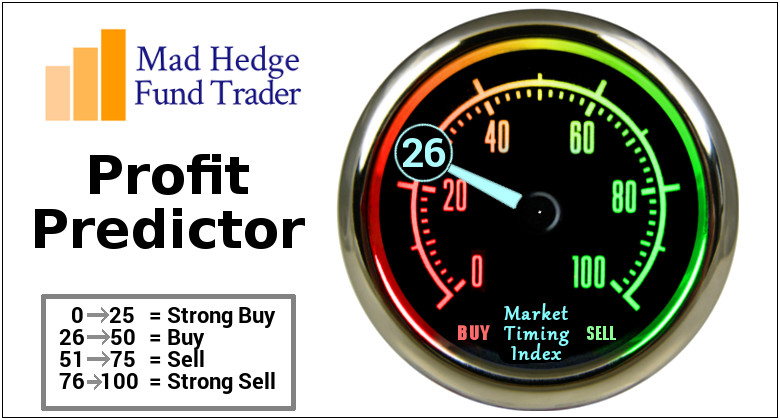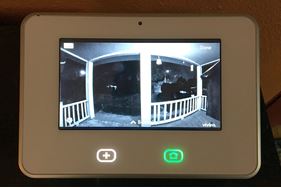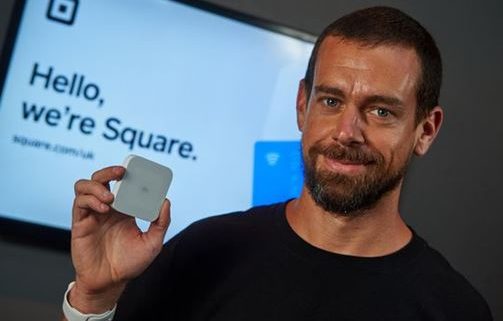When John identifies a strategic exit point, he will send you an alert with specific trade information as to what security to sell, when to sell it, and at what price. Most often, it will be to TAKE PROFITS, but, on rare occasions, it will be to exercise a STOP LOSS at a predetermined price to adhere to strict risk management discipline. Read more
When John identifies a strategic exit point, he will send you an alert with specific trade information as to what security to sell, when to sell it, and at what price. Most often, it will be to TAKE PROFITS, but, on rare occasions, it will be to exercise a STOP LOSS at a predetermined price to adhere to strict risk management discipline. Read more
While the Diary of a Mad Hedge Fund Trader focuses on investment over a one week to six-month time frame, Mad Day Trader, provided by Bill Davis, will exploit money-making opportunities over a brief ten minute to three day window. It is ideally suited for day traders, but can also be used by long-term investors to improve market timing for entry and exit points. Read more
Global Market Comments
March 7, 2018
Fiat Lux
Featured Trade:
(TAKE A LEAP INTO LEAPS), (AAPL),
(TESTIMONIAL),
(OPTIONS FOR THE BEGINNER)

Mad Hedge Technology Letter
March 7, 2018
Fiat Lux
Featured Trade:
(A STRAIGHT LINE TO PROFITS WITH SQUARE),
(AMZN), (JPM), (SQ), (TWTR), (WMT), (PYPL)

The recent rumor linking up Amazon (AMZN) with JP Morgan (JPM) to produce an Amazon branded bank account is not all that shocking.
Jeff Bezos seems to cause a stir with every finger he lifts.
But if I had to choose one man that will revolutionize the digital payment industry and banking it is not Jeff, but Square (CEO) Jack Dorsey.
Jack is the logical choice. Investors only need to see the proof in the pudding.
Without much hype, Jack Dorsey is in the midst of applying for a bank charter in the state of Utah.
This is in the form of an ILC (Industrial Loan Charter), only available in select states, which allows non-financial firms to enter the banking sector without any regulation or oversight by the Federal Reserve.
If you wondered why so many of your credit cards come for the Beehive State this is why.
This loophole would allow fintech companies to become fully-fledged financial players. ILC's are not subject to state licensing rules, which most legitimate banks must adhere to.
This is occurring during a more exaggerated backdrop of big tech scarcely being regulated at all. Small fines and slaps on the wrist don't meaningfully count.
Utah boasts over half of the ILC's currently in operation. The original purpose of the Utah ILC was to offer loans to blue collared workers around 1905-1910.
Other fintech companies employing this tactic is Sofi which Anthony Noto just took over and is part of the Softbank Vision Fund. Noto was the former COO of Twitter (TWTR) and was largely tabbed as the guy who turned around the ship there.
Lamentably, Anthony Noto left Twitter because of his aspirations to become a CEO, which was currently filled by Jack Dorsey. Yes, the same Jack Dorsey who is the CEO at Square.
Effectively, Anthony Noto left Twitter to duke it out with Jack Dorsey's other company Square. This has also given more credibility to Sarah Friar, CFO of Square, who just joined the Walmart (WMT) Board of Directors and is a true high flier.
It is assumed that with Noto's departure, Sarah Friar will pick up the slack at Square when Jack is putting Twitter's house in order across the street.
Sadly, Jack can't physically be in two places at one time. And an algorithm of himself has not been created yet.
Sarah Friar could be the next to jettison for a CEO position elsewhere as gaining a job credential from a Jack Dorsey company is digital crypto-gold.
At the micro level, Square is summed up by one number, GPV (Gross Payment Volume). It's the only metric investors look for. GPV on Square's platform surpassed $65 billion in 2017 and there no chance the upward trend will reverse in 2018.
Square (SQ) braggadocio stems from its brilliant pipeline of innovation.
The greatest benefit of being led by a super star visionary like Jack Dorsey is the high-quality offerings marinating in the pipeline.
Suffice it to say the quality is higher than relative to industry competitors allowing investors to double down on the Jack premium.
This was the same concept with the Steve Jobs premium at Apple (AAPL).
Once boards christen custodial type CEO's like Steve Ballmer and Tim Cook who are interested in shepherding the company instead of revolutionizing it, investors become disheartened for the lack of hyper-acceleration. Custodial CEO's tend to be reactive instead of proactive which is a self-defeating strategy.
Simply put, consumers love great products.
Investors are attracted to the fact that heavy hitters haven't adopted Square's services yet and Square is experiencing whirlwind momentum as they move upstream.
Up to this point, Square's success has been created on the back of small business growth. The momentum is a function of three points: product quality, distribution quality, and support services quality.
Over 80% of large merchants migrate to Square themselves. The easy to use platform directs these Fortune 500 companies effectively. They visit the website once, pay for the service they need, and do not need to communicate with anyone.
This vindicates the product existence and similar to Tesla (TSLA), they don't need physical dealers to sell. Customers find them and not the other way around.
Square Cash is fast becoming the millennial way to pay for things, which is Bearish for PayPal (PYPL). It's the easiest way to digitally send money. Cash is available for both personal and business use.
The Square Cash App is now available for trading Bitcoin (BTC) except for users in New York, Georgia, Hawaii, and Wyoming.
Even though the Bitcoin announcement will not drive the bulk of its business, the Bitcoin disclosure is a thinly veiled advertisement for its peers representing innovation and hyper-pace of transformation at Square.
This is the gumption that attracts top level engineers to Jack Dorsey's enterprises.
Other products that customers notice in stores is Square Register, which is a state of the art POS (Point of Sales) system. Also, there is Square Stand which is the iPad POS system that swivels around to customers from the cashier.
Square Capital is making inroads too with loan growth up 23% QOQ. Square capital provides business loans to small businesses. This is the part of the business that directly competes with SoFi.
On a financial level total net revenue is robust at $616 million QOQ, up 36% YOY and the 2018 calendar year will be even better for Square.
Square expect to offer expanding financial services for both sides of the transaction. The only limit to growth is its imagination, as is evident with the roll-out of new products almost every quarter.
Highlighting the extreme growth are invoices, virtual terminal, and e-commerce API payments, all commanding higher margins.
Subscription and service revenue rose 96% YOY. The ability for outsized growth of this scale through rapid product innovation and the chance to cross-sell into an embedded Square customer is essentially the cloudification seen in all tech companies these days.
In 2018, expect total net revenue to guide between $2.82 billion to $2.88 billion and represents a 32% YOY growth respectively.
Jack Dorsey is not a CEO to bet against and when a 96% bump in service and subscription revenue cannot even break into the top 3 reasons to buy this stock, investors know they have a gem on its hands.



While the Global Trading Dispatch focuses on investment over a one week to six-month time frame, Mad Options Trader, provided by Matt Buckley, will focus primarily on the weekly US equity options expirations, with the goal of making profits at all times. Read more
While the Diary of a Mad Hedge Fund Trader focuses on investment over a one week to six-month time frame, Mad Day Trader, provided by Bill Davis, will exploit money-making opportunities over a brief ten minute to three day window. It is ideally suited for day traders, but can also be used by long-term investors to improve market timing for entry and exit points. Read more
??AWhen John identifies a strategic exit point, he will send you an alert with specific trade information as to what security to sell, when to sell it, and at what price. Most often, it will be to TAKE PROFITS, but, on rare occasions, it will be to exercise a STOP LOSS at a predetermined price to adhere to strict risk management discipline. Read more
Is the $1 billion Amazon (AMZN) just spent for a doorbell company ludicrous, or genius? This question becomes incredibly pertinent as the battle for the front door heats up.
Transcending cultures since the time of antiquity, a door is a portal to a man's kingdom, his inner space.
Doors were first used inside Egyptian tombs some 5,000 years ago, and the Roman god Janus was the overseer of doors long before Jeff Bezos came along. Doors still continue to encapsulate beginnings, endings, transitions, and time.
A door is first and foremost an entrance. A potential entrance for Amazon to capture market share before the rules of the road are set.
Once entering the main door, hallways are linked with other rooms and other doors that lead to other worlds, which Amazon will pursue once they enter the home.
An open door represents the future and opportunity for a new market. A locked door typifies failure, rejection, and imprisonment. Amazon has created a $700 billion business that stops right outside your door. It's time for them to take the next step.
What would be the monetizing synergies if consumers offer access to that front door and Amazon slowly moves deeper into the house?
The goal is to remove any layers, material or psychological, that stands between Amazon profits and customers.
The door must be beaten down, and convincing consumers its permissible to enter the family sanctuary could fuel another round of tech prosperity and hyper- accelerating tech integration into daily lives.
It is fundamentally impossible to live a practical life in 2018 with analog instruments such as quaint pencil and paper. Consumers are increasingly addicted to technology, and future business applications revolve around harnessing tech acumen which cannot be rooted out retroactively.
The FOMO (Fear of Missing out) phenomenon that has gripped the business world is putting a turbocharger on this trend.
Remember that big tech companies aren't regulated like normal companies and have a built-in license to destroy any industry they desire.
This is immensely bullish for tech stocks. Regulation just cannot keep up. Tech companies believe that they should not be liable or accountable for any unintended consequences. Witness the Russia affair.
By contrast, media companies are harshly regulated by the government, and their content is subject to intense scrutiny. Remember Janet Jackson's infamous "wardrobe malfunction" at the Super Bowl? Unfortunately, media companies do not receive a free pass like the FANG's.
The FANG's free pass has put the family abode directly in the firing line. Alphabet (GOOGL) understands this to full effect; the new $229 Nest Doorbell will be distributed with a free Google Home Mini this spring.
Google Nest was purchased for $3.2 billion in 2014, and was launched by former Apple (AAPL) engineers Tony Fadell and Matt Rogers.
Google Nest has been accused by Ring CEO Jamie Siminoff of stealing their product innovation. Ring is the distinct best of breed in this industry and complements Amazon Key, which automatically opens doors for verified delivery workers.
This was the first adventure into this space by CEO and founder Jeff Bezos and supplements Amazon's Alexa which can cross-integrate with 3rd party devices in over 35,000 unique ways.
In a world where the demarcation of ecosystem lines are clearer and clearer by the day, the FANG's are seducing users into a proprietary closed ecosystem and padlocking anyone that is currently inside.
Facebook (FB) and Google do not sell anything, they just want user time, especially platform user time, to accumulate data to hawk ads to advertisers.
Apple, which does sell something physical, wants customers to buy iPhones, HomePods, and pay for its mish mash of services that integrate under the umbrella of the Apple smart home.
The FANG's have similar yet competing strategies. It is unknown how fast homes will become smart, as we are in the first stage of smartification. But there are a certain set of battleground products such as smart locks, thermostats and security cameras already.
Thermostats are easy to use, and various firms contribute energy rebates for thermostats upgrades.
The $1 billion spent on Ring, or Google's $3.2 billion tab for Nest Labs are FANG's intent to take a major stab at overtaking the place you sleep at night by making it socially acceptable for corporate tech to venture and operate inside houses.
The goal is to create a seamless, automated, enjoyable experience all on one pay tab called the smart home. After a consumer buys multiple products from the same tech company, they investigate further how to connect and integrate all these offerings together.
Thus, the tech climate fiercely focuses on admission into a new ecosystem by any means necessary.
If Amazon can seize the house, it will seize everything that is inside.
Smart homes will not work if the smattering of products and services derive from all different makers. You have to choose a common platform.
Unsurprisingly, home security companies sold off on this news, and this new trend has thrown a spanner into the works for firms such as ADT Inc. (ADT) who have curated a 30% market share. They are the first on the chopping block.
This Boca Raton, Florida company specializes in offering security to residential and small business enterprises. They possess far more weight in the industry compared to rivals Johnson Controls International (JCI) and private firm Vivint.
ADT went public in January 2018 and expected to garner a price of $17-$19. ADT is trading below $11 today. Some of the headwinds analysts have previously mentioned are "increased competition", but nobody thought competition would come in the form of the most powerful company ever to be created in the history of mankind - Amazon. Ouch!
Ironically, in January 2016, Vivint, formerly known as??APX Alarm Security Solutions Inc, agreed to cooperate with Amazon and Nest. Vivint Element team is working on its own smart thermostat and the Vivint Ping Camera for front doors.
This is not a coincidence and the mutual connectivity in tech is everywhere. There are fewer degrees of separation between companies and industries than ever before.
Everyone is overlapping to the point where Amazon refuses to sell Google Nest products on its interface and Google stripping YouTube from all Amazon streaming devices. The more successful these smaller players become, the greater chance of a takeover by a more liquid player.
The FANG's have become juggernauts and any remnant of competition is undercut before it can become a threat and neatly placed under the umbrella of their greater visions.
This strategy has been rampant with botched attempts like Mark Zuckerberg's failed purchase of Snapchat (SNAP) for $3 billion in 2013 and Yahoo's failed buy of Facebook for $1 billion in 2006, just before Zuckerberg launched the fabled news feed.
Even though Vivint is not owned by a FANG, Blackstone Group acquired them for more than $2 billion in 2012.
If you look back in time, Amazon should have never become Amazon. Walmart should have bought it before it gained any traction. Same goes for search - Yahoo should have bought out Google before it became Google. Such is the incredible value of 20/20 hindsight.
Siminoff's Ring is now part of Amazon's death star. Ultimately, if doors are associated with privacy and protection and Amazon can successfully maneuver around these certain sensitive elements, its share will go ballistic.




Is That Google Watching?
Legal Disclaimer
There is a very high degree of risk involved in trading. Past results are not indicative of future returns. MadHedgeFundTrader.com and all individuals affiliated with this site assume no responsibilities for your trading and investment results. The indicators, strategies, columns, articles and all other features are for educational purposes only and should not be construed as investment advice. Information for futures trading observations are obtained from sources believed to be reliable, but we do not warrant its completeness or accuracy, or warrant any results from the use of the information. Your use of the trading observations is entirely at your own risk and it is your sole responsibility to evaluate the accuracy, completeness and usefulness of the information. You must assess the risk of any trade with your broker and make your own independent decisions regarding any securities mentioned herein. Affiliates of MadHedgeFundTrader.com may have a position or effect transactions in the securities described herein (or options thereon) and/or otherwise employ trading strategies that may be consistent or inconsistent with the provided strategies.


